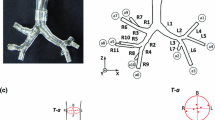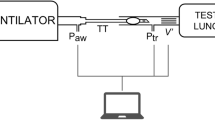Abstract
We measured the pressure/flow relationships in a cast of human upper and central airways at high frequencies (3, 5, 8, 10, 12 and 15 Hz) and low stroke volumes (70, 110, 150 and 230 cm3). A particular effort was made to analyse the effect of the larynx on the pressure/flow relationships by comparing the experimental measurements obtained both with and without larynx. The larynx was found to have an effect on airflow patterns, increasing both turbulence and airway resistance. The phase lead of pressure relative to flow was smaller in the presence of the larynx than in its absence, indicating an increase in the resistive part of impedance by the larynx. In a dimensionless Moody plot of peak pressure and peak flow, data obtained at the various frequencies and stroke volumes formed a single curve as the steady-flow theory predicts, indicating an appearance of quasi-steady-state behaviour. In this case, the tracheal Reynolds number alone governs the dimensionless pressure drop. Plotted against Re/a (ratio of Reynolds and Womersley numbers) the normalised instantaneous pressure drop was generally smooth throughout the range of Re/α except for the appearance of a transition at the lowest frequency suggesting the onset of turbulent flow.
Similar content being viewed by others
Abbreviations
- a :
-
constant ranging between 1 and 2
- Cd :
-
discharge coefficient
- d :
-
diameter of the trachea
- f :
-
oscillation frequency
- Fn :
-
function
- K :
-
constant depending on airway geometry
- ΔP :
-
pressure difference
- ΔP m :
-
maximum pressure drop
- Re :
-
Reynolds number
- Re m :
-
maximum Reynolds number in the trachea
- S :
-
cross-sectional area
- u :
-
average velocity
- U m :
-
maximum mean velocity in the trachea
- V s :
-
stroke volume
- \(\dot V\) :
-
flow rate
- ω:
-
angular frequency
- α:
-
Womersely parameter
- α* :
-
turbulent unsteadiness parameter
- μ:
-
dynamic viscosity
- ν:
-
kinematic viscosity
- v * :
-
eddy viscosity
- σ:
-
density
- ϕ:
-
phase shift
References
Akhavan, R. andKamm, R. D. (1984) Pressure excursions during flow in a branching network of tubes.J. Appl. Physiol.,57, 665–673.
ben Jebria, A., Tabka, Z. andTechoueyres, P. (1987) Steady pressure-flow relationship in a cast model of the upper and central human airways.Int. J. Bio-Med. Comput.,20, 97–105.
Brancatisano, T., Collett, P. W. andEngel, L. A. (1983) Respiratory movements of the vocal cords.J. Appl. Physiol.,54, 1268–1267.
Dekker, E. (1961) Transition between laminar and turbulent flow in human trachea.,16, 1060–1064.
Drazen, J. M., Loring, S. H. andIngram, R. H. (1976) Distribution of pulmonary resistance: effect of gas density, viscosity and flow-rate.,41, 385–395.
Gavriely, N., Solway, J., Loring, S. H., Butler, J. P., Slutsky, A. S. andDrazen, J. M. (1985) Pressure-flow relationships of endotracheal tubes during high-frequency ventilation.,59, 3–11.
Hino, M., Sawamoto, M. andTakasu, S. (1976) Experiments on transition to turbulence in oscillatory pipe flow.J. Fluid Mech.,75, 193–207.
Isabey, D. andChang, H. K. (1981) Steady and unsteady pressure-flow relationships in central airways.J. Appl. Physiol.,51, 1338–1348.
Jaeger, M. J. andMatthys, H. (1970) The pressure flow characteristics of the human airways. InAirway dynamics, physiology and pharmacology.Bouhuys, A. (Ed.), Thomas, Springfield, Illinois, 21–32.
Jaffrin, M. Y. andHennessey, T. V. (1972) Pressure distribution in a model of the central airways for sinusoidal flow.Bull. Physiopath. Resp.,8, 375–390.
Jaffrin, M. Y. andKesic, P. (1974) Airway resistance: a fluid mechanical approach.J. Appl. Physiol.,36, 354–361.
Menon, A. S., Weber, M. E. andChang, H. K. (1985) Effect of the larynx on oscillatory flow in the central airways: a model study.,59, 160–169.
Merkli, P. andThomann, H. (1975) Transition to turbulence in oscillating pipe flow.J. Fluid Mech. 68, 567–575.
Olson, D. E., Iliff, L. D. andSudlow, M. F. (1972) Quelques aspets physiques de l'écoulement gazeux dans les voies aériennes centrales.Bull. Physiopath. Resp. 8, 391–408.
Pedley, T. J., Schroter, R. C. andSudlow, M. F. (1970) The prediction of pressure drop and variation of resistance within the human bronchial airways.Respirat. Physiol.,9, 387–405.
Pedley, T. J., Schroter, R. C. andSudlow, M. F. (1977) Gas flow and mixing in the airways. InBioengineering aspects of the lung.West, J. B. (Ed.), Marcel Dekker, New York, 163–265.
Pedley, T. J. (1977) Pulmonary fluid mechanics.Ann. Rev. Fluid Mech.,9, 229–274.
Reynolds, D. B. andLee, J. S. (1981) Steady pressure flow relationship or a model of the canine bronchial tree.J. Appl. Physiol.,51, 1072–1079.
Rohrer, F. (1915) Ser Stromungswiderstand in den menschlichen Atmwegen und der Einfleis der unregelmassigen Verzweigung des bronchial systems auf den Atmungsverlauf in verschifdenen Lungenbezirken.Pflügers Arch.,162, 225–299.
Schroter, R. C. andSudlow, M. F. (1969) Flow patterns in models of the human bronchial airways.Respirat. Physiol.,7, 341–355.
Simone, A. F. andUltman, J. S. (1982) Longitudinal mixing by the human larynx.,49, 187–203.
Slutsky, A. S., Berdine, G. G. andDrazen, J. M. (1980) Steady flow in a model of human central airways.J. Appl. Physiol.,49, 417–423.
Stanescu, D. C., Pattijn, J., Clement, J. andvan de Woestijne, K. P. (1972) Glottis opening and airway resistance.,32, 460–466.
Wood, L. D. H., Engel, L. A., Griffin, P., Despas, P. andMacklem, P. T. (1976) Effect of gas physical properties and flow on lower pulmonary resistance.,41, 234–244.
Author information
Authors and Affiliations
Rights and permissions
About this article
Cite this article
Jebria, A.B., Choukroun, M.L., Tabka, Z. et al. High-frequency oscillatory pressure/flow relationship in the airways of laryngo-tracheo-bronchial tree casts. Med. Biol. Eng. Comput. 26, 476–482 (1988). https://doi.org/10.1007/BF02441914
Received:
Accepted:
Issue Date:
DOI: https://doi.org/10.1007/BF02441914




